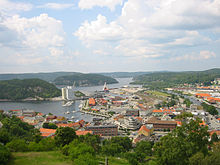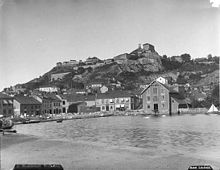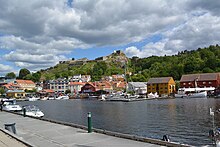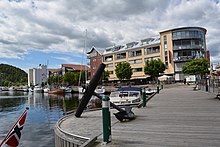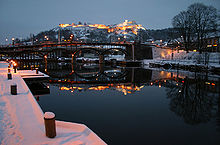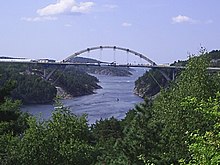Halden (Norway)
| coat of arms | map | |
|---|---|---|

|
|
|
| Basic data | ||
| Commune number : | 3001 | |
| Province (county) : | Viken | |
| Administrative headquarters: | Heaps | |
| Coordinates : | 59 ° 7 ' N , 11 ° 23' E | |
| Surface: | 642.31 km² | |
| Residents: | 31,373 (Feb 27, 2020) | |
| Population density : | 49 inhabitants per km² | |
| Language form : | Bokmål | |
| Website: | ||
| traffic | ||
| Railway connection: | Østfoldbanen | |
| politics | ||
| Mayor : | Anne-Kari Holm ( Sp ) (2019) | |
| Location in the province of Viken | ||

|
||
, between 1665 and 1928Fredrikshald, is a city andmunicipalityinNorway.
geography
location
Halden is in the province ( Fylke ) Viken in the southeast of Norway. Only three kilometers separate the place from the border with the Swedish province of Västra Götalands län . This runs through the middle of the Iddefjord , which extends to the western edge of Halden. Halden lies on both sides of the mouth of the Tista River into the Iddefjord. The city is around ten kilometers from the North Sea coast. In 1966 Berg and 1967 Idd, which were previously independent municipalities, were incorporated into Halden.
Neighboring communities
The Norwegian municipalities of Aremark , Rakkestad and Sarpsborg are in the north. The Swedish municipalities of Dals-Ed , Tanum and Strömstad are in the east, south and west.
history
historical overview
Halden can look back on 8,000 years of uninterrupted settlement. The sawmill along the Tista River and the export of wood formed the basis of the Halden loading area in the 17th century. The peace treaty of Roskilde in 1658, when Norway had to cede the province of Bohuslän to Sweden, meant that Halden was now in the immediate vicinity of the border with Sweden. Between 1658 and 1660 Halden was attacked by the Swedes three times without success. Therefore the city had to be fortified. On July 16, 1660, King Fredrik III signed the decision to build a fortress. This should be named Fredriksten . In 1665 Halden was given city rights and the new name Frederikshald as a thank you for helping with the national defense. Since then, the words “God with us” (Norwegian: Gud med oss ) have been part of the city's coat of arms. In 1718 the Swedish King Charles XII conquered . Frederikshald and attacked Fredriksten. He did not succeed in taking the fortress. The Haldensians set fire to their city to Charles XII. and drive out his soldiers. The national poet Bjørnstjerne Bjørnson immortalized these deeds in a verse of the Norwegian national anthem . Denmark had to cede Norway to Sweden in 1814. After the fire of 1826, the city was rebuilt in the French Empire style and therefore also called " Empire City ". After Norway's unilateral declaration of independence on June 7, 1905, thousands of soldiers were mobilized again on both sides of the Norwegian-Swedish border until a peaceful solution was found in the Karlstad Treaty . During the German occupation 1940–1945 there was an extensive pilot assignment in Halden for refugee traffic to Sweden.
Per Kristian Dahl from the Arbeiderpartiet was mayor from 2003 to 2011.
Origin of name
Halden was named after the small farm Hallen , which means something like ascent or slope . The name was first mentioned in 1629. The city was called Fredrikshald between 1665 and 1928 (also: Frederikshall or Friedrichshall ) and was named after the Danish-Norwegian King Fredrik III. named.
Culture and sights
Attractions
- The Fredriksten Fortress is situated on a hill above the town and offers a good view of the city, the harbor and the fjord. It was built in 1661–1671 and 1682–1701 to protect it from the Swedes. The fortress was built on two elevations. On the north are the Queen and Prince Christian bastions and on the south the Prince George bastion and the Overkongen bastion. The citadel lies between these two parts of the fortress . The Bürgerwall protects the western slope. Fredriksten Fortress was the scene of the violent death of the Swedish King Charles XII. during the siege of Frederikshald on December 11th, 1718, although it is not certain whether it was an enemy bullet or a conspirator's bullet.
- The Fredrikshalds Theater from 1838 is Norway's only surviving baroque stage, which also has a large collection of old stage sets.
- The Immanuelskirche by architect Christian Grosch was inaugurated in 1833 and is considered Norway's most important Empire church.
- The Busterudpark , which was laid out in the 1870s, is a reminder of the traditional local musical life with its music pavilion and the monument to the composers Friedrich August Reissiger and Oscar Borg .
- In the former cotton mill in Tistedal you can see exhibitions on the cotton, stone and shoe industries.
- Rød Herregård Manor was built in the first half of the 18th century and has an English garden with a walnut avenue and symmetrical paths. In the main building there is a collection of historical weapons and hunting trophies. Art and cultural history exhibitions take place in the Rød Gallery.
- The Jellhaugen is a large burial mound in Gjellestad in Halden.
Other structures
The Høiåsmasten transmission tower , a concrete tower with a guyed steel truss mast on top, is the second tallest structure in Norway.
Halden prison, designed by architect Erik Møller , is one of the most humane prisons in the world.
Economy and Infrastructure
traffic
Six kilometers west of Halden is the E6 with the busiest border crossing at the Svinesund bridges over the Iddefjord. The first granite bridge was inaugurated in 1946. The new Svinesund Bridge with a length of 704 meters and a height of 92 meters over the fjord was opened in 2005. Halden can be reached on the E6 north of Gothenburg via the Blå-Grønne Veien (the blue-green road) or road 22. In Halden begins the 900 km long Norwegian Villmarksveien (the wilderness road) or road 21, which runs in the border area with Sweden through the wooded eastern Norway to Trondheim .
In inland navigation, the Haldenvassdraget water system near Tistedal leads to the Halden Canal . In the past, the water system was used to raft the tree trunks to the sawmills at Tistedalsfoss.
The Østfoldbanen connects Oslo with Sweden in long-distance rail traffic via Halden. Halden has a border station on this connection .
Economic development
As early as 1815 a cotton spinning and weaving mill was built in Tistedal, which operated until 1971 and had around 400 employees at peak times. In the 1840s, granite mining began on Iddefjord, which was of economic importance to the city for over 100 years. Granite was exported on a large scale. The monolith in Vigelandpark in Oslo was carved out of a 2600-ton granite block from Iddefjord. A granite block from heaps in the courtyard of the Nordic embassies in Berlin reminds of these traditions today . The first shoe factories were founded in Halden in the 1890s. In the middle of the 20th century, 17 shoe factories were in operation in Halden. At that time Halden was called Norway's “shoe capital”. The production of beer, which began in Halden in 1855, is continued today by the Hansa-Borg brewery , the second largest in Norway. With Norske Skog , one of the leading Norwegian paper manufacturers is based in Halden. The chemical and electronic industries are other economic pillars of the city. A subsidiary of the Alcatel Cable Group produces high-voltage submarine cables and special products for the offshore industry.
The Halden detention center was opened in spring 2010 .
Research and education
Halden is Østfold's university, research and development center. The research institutions are among the largest in the country. At the eastern edge of the city is the Institute for Atomic Energy with a research reactor that was put into operation in 1959. On October 24, 2016, a poorly communicated incident with low radioactivity release occurred in this reactor, which was later classified as INES 1. The reactor is a heavy water moderated boiling water reactor , with which research work for the commercial light water reactors that do not exist in Norway is carried out worldwide. In May 2020 it became known that test results had been falsified and material tests manipulated for decades.
There is a district university and a teacher training college in Halden .
sons and daughters of the town
- Carsten Anker , b. as Ancher (1747–1824), businessman and politician
- Johan Anker (1871–1940), sailor, Olympic champion, yacht designer and shipyard owner
- Peter Anker , b. as Ancher (1744–1832), diplomat, governor in Tranquebar, art collector
- Oscar Borg (1851–1930), composer
- Sven Elvestad (1884–1934), journalist, writer and translator
- Thomas Fearnley (1802-1842), painter
- Carsten Hauch (1790–1872), Danish physicist and poet
- Iver Hvitfeldt (1665–1710), Norwegian-Danish admiral
- Sophus Jacobsen (1833–1912), landscape painter
- Herman Ludin Jansen (1905–1986), theologian, religious historian and university professor
- Arvid Johanson (1929-2013), politician
- Eva Kolstad (1918–1999), politician
- Gustav Lange (1861–1939), composer
- Emilie Moberg (* 1991), racing cyclist
- Ole-Jørgen Nilsen (1936–2008), actor and theater director
- Johann Friedrich Sehestedt (1725–1785), Danish lieutenant general
- Malene Staal (* 1991), handball player
- Lars Sponheim (* 1957), liberal politician and Minister of Agriculture
literature
- Halden Turist (Ed.): Visit Halden. 2011.
- Halden Turist (Ed.): Halden and Aremark. 2000.
Individual evidence
- ↑ Statistisk sentralbyrå - Befolkning
- ↑ Historical view from 1729: Delineatio Oppidi Halldæ in Norwegia from Exell. Dn. Campi Marescallo Comite Laurentio Kagge d. January 21. 1660. obsidione cinctæ sed 23 February eadem liberatæ. ( Digitized version )
- ↑ Fuel fail and emission from research reactor
- ↑ ENSI : Experience and Research Report 2011
- ↑ Deutschlandfunk : [ https://www.deutschlandfunk.de/forschungsreaktor-halden-norwegen-faelscht-testerverbindungen.676.de.html?dram:article_id=477337 forschungsreaktor-halden-norwegen-faelscht-test results], from May 26th 2020, loaded on June 28, 2020

